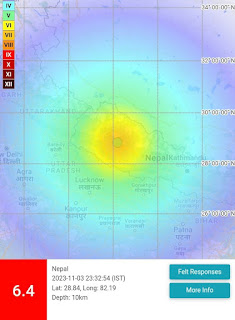New Delhi, NCR, UP, Bihar, and Uttarakhand -
A powerful earthquake struck northern India, sending shockwaves through regions including Delhi-NCR, Uttar Pradesh, Bihar, and Uttarakhand. According to initial reports, the tremors were felt for approximately 20 seconds, causing panic among the residents. The epicenter of the earthquake has been located in Nepal. The intense jolts from the earthquake prompted people to rush out of their homes. Many reported feeling the tremors for an extended period.
The earthquake registered a magnitude of 6.4 on the Richter scale, indicating a significant seismic event. The earthquake's coordinates were recorded at 28.84 degrees latitude and 82.19 degrees longitude, with a depth of 10 kilometers.
Seismologists explain that the Earth's crust is divided into seven tectonic plates, which constantly move. Areas where these plates interact are known as fault lines. Over time, as these plates collide, they can shift and generate pressure. When the pressure becomes too great, the plates rupture, releasing energy, and causing an earthquake.
Understanding the Epicenter and Magnitude
The epicenter of an earthquake is the point on the Earth's surface directly above where the energy is released from beneath the tectonic plates. The shaking is most intense at the epicenter and diminishes as you move farther away. However, if an earthquake measures 7 or higher on the Richter scale, the impact can be felt within a radius of approximately 40 kilometers. The extent of the affected area also depends on whether the seismic waves are traveling upward or within the Earth's crust. If the waves are directed upwards, the affected area may be smaller.
Measuring Earthquake Magnitude
The magnitude of an earthquake is typically measured using the Richter scale. This scale assigns a numerical value ranging from 1 to 9 to quantify the earthquake's intensity. The measurement is made from the earthquake's epicenter, where the energy is released beneath the Earth's surface. The Richter scale quantifies the intensity of the seismic waves generated by the earthquake, providing an estimate of its destructive potential.
In times of an earthquake, the Richter scale helps gauge the level of peril associated with the tremors, enabling authorities to respond accordingly.
This recent earthquake serves as a stark reminder of the seismic activity prevalent in this region, emphasizing the importance of preparedness and disaster management to mitigate potential risks. Authorities and experts will continue to monitor the situation and assess any damages or aftershocks that may occur in the aftermath of this earthquake.










